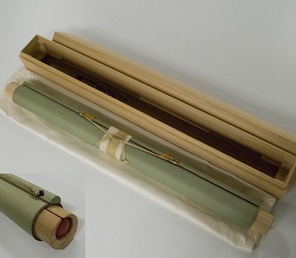When it comes to hanging scrolls, conservators believe that preventive care is the best medicine.
The hanging scrolls in our galleries may look pristine, but like most art they become increasingly fragile with age. Silk fabrics become brittle and may crumble at a touch. Hanging cords can gradually fray, then break when you least expect it. Very often, the flexible paper layers beneath the painting become stiff or distorted. We can’t stop time, but many of these problems can be alleviated by careful handling and good storage practices. To best protect the East Asian paintings collections, the museum’s Conservation Department checks the condition of each painting before it is displayed. Paintings with signs of damage or flaking are often given special hanging systems, extra support, and minor repairs. Following these general guidelines can help avoid major problems. Eventually a scroll may need to be remounted, but the risks and expense mean that step is always the last resort.
Scrolls are complex structures made of layers of paper, silk, and paint. Too much heat, humidity, or light can cause the layers to separate or warp, and the colors to fade quickly. Try to display scrolls under low light, in a protected area such as a niche or wall case, and only for brief periods of time.

Opening and closing a rolled painting adds wear and tear. Roll and unroll scrolls on a clean, flat wall or table. Roll and tie them smoothly and not too tight. The video above shows Shiho Sasaki, Conservator of Paintings, installing a painting in our Tea Room.
When not on display, always keep your scrolls rolled, wrapped, and in a secure box. Some scrolls can benefit from a futomaki (a special insert which can support a scroll when it is rolled).

You can often find the first signs of damage to a scroll at the top and bottom edges, where the support rods are attached. Always check these areas and if they appear torn or weakened, consult a professional conservator about repairs. Small tears can quickly become big problems. The traditional silk hanging cords should also be checked, and repaired if they are loose or frayed.

Before assuming that your scroll needs to be completely remounted, consider minor repairs. A professional scroll conservator can sometimes add small, non-intrusive reinforcements to the back of a scroll instead. If done in time, such minor repairs can slow down the development of creases and extend the life of a mount.

Properly constructed and cared for, a scroll mount may last a century or more. But if damage to the mount becomes too severe, the painting itself may be at risk and a new mount may be recommended. To decide, always consult one or more qualified conservators who are experts in scroll mounts. The technique and style of a new mount will impact your painting for better or worse for decades to come, so make sure the treatment is genuinely needed and you are familiar with the risks and costs in advance. As with all conservation treatments, remember to properly document the condition of your scroll with images, measurements and written records before it is treated. To see an example of a remounted scroll, visit our page on Korean paintings.